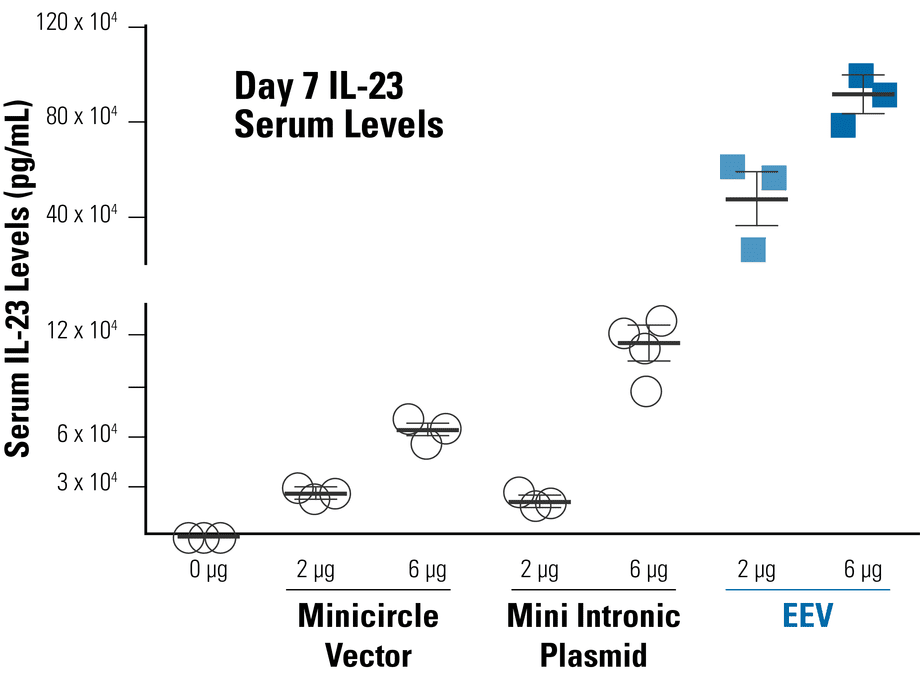CAGs-mIL-23 Enhanced Episomal Vector (EEV)
- High levels of expression
- Easy to clone formats
- No special plasmid production
- Nonviral, non-integrating technology
- Constitutive and inducible vector formats
Products
| Catalog Number | Description | Size | Price | Quantity | Add to Cart | |||
|---|---|---|---|---|---|---|---|---|
| EEV651A-1 | Mouse IL-23 Enhanced Episomal Expression Vector | 100 µg | $1090 |
|
||||
Overview
Overview
An easy-to-produce non-integrating option for constitutive mouse IL-23 expression
With the CAGs-mIL-23 Enhanced Episomal Vector (EEV), you can get sustained, long-lasting, and non-viral expression of the mouse IL-23 gene from a non-integrating vector. Driven by the constitutive CAG promoter, the CAGs-mIL-23 EEV works in most cell types, including primary cells and stem cells, and can even be directly injected into mice.
 With virtually no limits on insert size (unlike AAV vectors) Enhanced Episomal Vectors (EEVs) are an excellent choice for non-integrating, non-viral gene expression. Because they replicate in synchrony with the host cell, they are stably inherited and can be used for long-lasting expression—up to several months both in vitro and in vivo—without modifying the host genome. SBI’s EEV System, which is an enhanced version of the Epstein-Barr Nuclear Antigen-1 (oriP-EBNA1) system, offers:
With virtually no limits on insert size (unlike AAV vectors) Enhanced Episomal Vectors (EEVs) are an excellent choice for non-integrating, non-viral gene expression. Because they replicate in synchrony with the host cell, they are stably inherited and can be used for long-lasting expression—up to several months both in vitro and in vivo—without modifying the host genome. SBI’s EEV System, which is an enhanced version of the Epstein-Barr Nuclear Antigen-1 (oriP-EBNA1) system, offers:
- High levels of expression
- Easy to clone formats
- No special plasmid production
- Nonviral, non-integrating technology
- Constitutive and inducible vector formats
References
How It Works
Supporting Data
Supporting Data
Sustained, non-integrating expression of mouse IL-23 in vivo via EEV
Figure 1. A constitutive EEV reporter based on CAGs-MCS leads to higher serum IL-23 levels in mice than two other episomal vector systems. We compared SBI’s EEV system to two other episomal vector systems—minicircle technology1 and the mini-intronic plasmid system2—using a mouse IL-23 cDNA cloned into the three different vectors. We introduced the three vectors or vehicle only into mice using hydrodynamic tail vein delivery (HDD). After seven days, we measured serum IL-23 levels using an ELISA assay and found that the EEV technology outperformed the other episomal platforms by at least 10-fold, demonstrating the ability of the EEV platform to provide sustained, long-lasting transgene expression.
References
- Kay MA, He CY, and Chen ZY. A robust system for production of minicircle DNA vectors. Nat Biotechnol. 2010 Dec; 28(12):1287-9. PMCID: PMC4144359.
- Lu J, Zhang F, and Kay MA. A mini-intronic plasmid (MIP): a novel robust transgene expression vector in vivo and in vitro. Mol Ther. 2013 May; 21(5):954-63. PMCID: PMC3666631.
FAQs
Documentation
Citations
Related Products
Products
| Catalog Number | Description | Size | Price | Quantity | Add to Cart | |||
|---|---|---|---|---|---|---|---|---|
| EEV651A-1 | Mouse IL-23 Enhanced Episomal Expression Vector | 100 µg | $1090 |
|
||||
Overview
Overview
An easy-to-produce non-integrating option for constitutive mouse IL-23 expression
With the CAGs-mIL-23 Enhanced Episomal Vector (EEV), you can get sustained, long-lasting, and non-viral expression of the mouse IL-23 gene from a non-integrating vector. Driven by the constitutive CAG promoter, the CAGs-mIL-23 EEV works in most cell types, including primary cells and stem cells, and can even be directly injected into mice.
 With virtually no limits on insert size (unlike AAV vectors) Enhanced Episomal Vectors (EEVs) are an excellent choice for non-integrating, non-viral gene expression. Because they replicate in synchrony with the host cell, they are stably inherited and can be used for long-lasting expression—up to several months both in vitro and in vivo—without modifying the host genome. SBI’s EEV System, which is an enhanced version of the Epstein-Barr Nuclear Antigen-1 (oriP-EBNA1) system, offers:
With virtually no limits on insert size (unlike AAV vectors) Enhanced Episomal Vectors (EEVs) are an excellent choice for non-integrating, non-viral gene expression. Because they replicate in synchrony with the host cell, they are stably inherited and can be used for long-lasting expression—up to several months both in vitro and in vivo—without modifying the host genome. SBI’s EEV System, which is an enhanced version of the Epstein-Barr Nuclear Antigen-1 (oriP-EBNA1) system, offers:
- High levels of expression
- Easy to clone formats
- No special plasmid production
- Nonviral, non-integrating technology
- Constitutive and inducible vector formats
References
How It Works
Supporting Data
Supporting Data
Sustained, non-integrating expression of mouse IL-23 in vivo via EEV
Figure 1. A constitutive EEV reporter based on CAGs-MCS leads to higher serum IL-23 levels in mice than two other episomal vector systems. We compared SBI’s EEV system to two other episomal vector systems—minicircle technology1 and the mini-intronic plasmid system2—using a mouse IL-23 cDNA cloned into the three different vectors. We introduced the three vectors or vehicle only into mice using hydrodynamic tail vein delivery (HDD). After seven days, we measured serum IL-23 levels using an ELISA assay and found that the EEV technology outperformed the other episomal platforms by at least 10-fold, demonstrating the ability of the EEV platform to provide sustained, long-lasting transgene expression.
References
- Kay MA, He CY, and Chen ZY. A robust system for production of minicircle DNA vectors. Nat Biotechnol. 2010 Dec; 28(12):1287-9. PMCID: PMC4144359.
- Lu J, Zhang F, and Kay MA. A mini-intronic plasmid (MIP): a novel robust transgene expression vector in vivo and in vitro. Mol Ther. 2013 May; 21(5):954-63. PMCID: PMC3666631.


